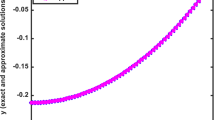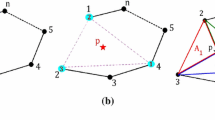Abstract
The singular boundary method (SBM) is a recent meshless boundary collocation method that remedies the perplexing drawback of fictitious boundary in the method of fundamental solutions (MFS). The basic idea is to use the origin intensity factor to eliminate singularity of the fundamental solution at source. The method has so far been applied successfully to the potential and elasticity problems. However, the SBM solution for large-scale problems has been hindered by the operation count of O(N3)with direct solvers or O(N2)with iterative solvers, as well as the memory requirement of O(N2). In this study, the first attempt was made to combine the fast multipole method (FMM) and the SBM to significantly reduce CPU time and memory requirement by one degree of magnitude, namely, O(N). Based on the complex variable representation of fundamental solutions, the FMM-SBM formulations for both displacement and traction were presented. Numerical examples with up to hundreds of thousands of unknowns have successfully been tested on a desktop computer. These results clearly illustrated that the proposed FMM-SBM was very efficient and promising in solving large-scale plane elasticity problems.
Similar content being viewed by others
References
Chen, W. and Wang, F.Z., A method of fundamental solutions without fictitious boundary. Engineering Analysis with Boundary Elements, 2010, 34(5): 530–532.
Chen, W. and Gu, Y., An improved formulation of singular boundary method. Advances in Applied Mathematics and Mechanics, 2012, 4(5): 543–558.
Wang, H. and Qin, Q.H., Some problems with the method of fundamental solution using radial basis functions. Acta Mechanica Solida Sinica, 2007, 20(1): 21–29.
Qu, W.Z. and Chen, W., Solution of two-dimensional stokes flow problems using improved singular boundary method. Advances in Applied Mathematics and Mechanics, 2015, 7(1): 13–30.
Gu, Y., Chen, W. and He, X.Q., Domain-decomposition singular boundary method for stress analysis in multi-layered elastic materials. Computers Materials and Continua, 2012, 29(2): 129.
Rokhlin, V., Rapid solution of integral equations of classical potential theory. Journal of Computational Physics, 1985, 60(2): 187–207.
Greengard, L.F., The Rapid Evaluation of Potential Fields in Particle Systems. MIT press, 1988.
Greengard, L. and Rokhlin, V., A fast algorithm for particle simulations. Journal of Computational Physics, 1987, 73(2): 325–348.
Warren, M.S. and Salmon, J.K., Astrophysical N-body simulations using hierarchical tree data structures. In: Supercomputing’92. Proceedings, IEEE, 1992: 570–576.
Board Jr, J.A., Causey, J.W., Leathrum Jr, J.F., Windemuth, A. and Schulten, K., Accelerated molecular dynamics simulation with the parallel fast multipole algorithm. Chemical Physics Letters, 1992, 198(1–2): 89–94.
Salmon, J.K., Warren, M.S. and Winckelmans, G.S., Fast parallel tree codes for gravitational and fluid dynamical N-body problems. International Journal of Supercomputer Applications, 1994, 8(2): 129–142.
Chew, W.C., Chao, H.Y., Cui, T.J., Lu, C.C., Ohnuki, S., Pan, Y.C., Song, J.M., Velamparambil, S. and Zhao, J.S., Fast integral equation solvers in computational electromagnetics of complex structures. Engineering Analysis with Boundary Elements, 2003, 27(8): 803–823.
Nishimura, N. and Liu, Y.J., Thermal analysis of carbon-nanotube composites using a rigid-line inclusion model by the boundary integral equation method. Computational Mechanics, 2004, 35(1): 1–10.
Wang, H.T. and Yao, Z.H., Application of a new fast multipole BEM for simulation of 2D elastic solid with large number of inclusions. Acta Mechanica Sinica, 2004, 20(6): 613–622.
Chen, Z.J. and Xiao, H., The vectorization expressions of Taylor series multipole-BEM for 3D elasticity problems. Computational Mechanics, 2009, 43(2): 297–306.
Yu, C.X., Shen, G.X. and Liu, D.Y., Program-pattern multipole boundary element method for frictional contact. Acta Mechanica Solida Sinica, 2005, 18(1): 76–82.
Neves, A. and Brebbia, C., The multiple reciprocity boundary element method in elasticity: A new approach for transforming domain integrals to the boundary. International Journal for Numerical Methods in Engineering, 1991, 31(4): 709–727.
Sokolnikoff, I.S. and Specht, R.D., Mathematical Theory of Elasticity. McGraw-Hill, New York, 1956.
Nishimura, N., Fast multipole accelerated boundary integral equation methods. Applied Mechanics Reviews, 2002, 55(4): 299–324.
Mammoli, A.A. and Ingber, M.S., Stokes flow around cylinders in a bounded two-dimensional domain using multipole-accelerated boundary element methods. International Journal for Numerical Methods in Engineering, 1999, 44(7): 897–917.
Wang, H.T., Yao, Z.H. and Wang, P.B., On the preconditioners for fast multipole boundary element methods for 2D multi-domain elastostatics. Engineering Analysis with Boundary Elements, 2005, 29(7): 673–688.
Yoshida, K.I., Nishimura, N. and Kobayashi, S., Application of fast multipole Galerkin boundary integral equation method to elastostatic crack problems in 3D. International Journal for Numerical Methods in Engineering, 2001, 50(3): 525–547.
Wang, Q., Miao, Y. and Zhu, H., A fast multipole hybrid boundary node method for composite materials. Computational Mechanics, 2013, 51(6): 1–13.
Liu, Y. J., A new fast multipole boundary element method for solving large-scale two-dimensional elastostatic problems. International Journal for Numerical Methods in Engineering, 2006, 65(6): 863–881.
Tang, L.M., The stress concentration problems for adjacent circular holes. Journal of Dalian University of Technology, 1959, 6(1): 31–48.
Author information
Authors and Affiliations
Corresponding author
Additional information
Project supported by the National Basic Research Program of China (973 Project, No. 2010CB832702), the National Science Funds for Distinguished Young Scholars of China (No. 11125208), the National Natural Science Foundation of China (Nos. 11125208 and 11302069), the 111 project under Grant B12032, Jiangsu Province Graduate Students Research and Innovation Plan (No. KYZZ_0138), and the scholarship from the China Scholarship Council (CSC) (No. 201306710026).
Rights and permissions
About this article
Cite this article
Qu, W., Chen, W. Fast Multipole Singular Boundary Method for Large-Scale Plane Elasticity Problems. Acta Mech. Solida Sin. 28, 626–638 (2015). https://doi.org/10.1016/S0894-9166(16)30004-0
Received:
Revised:
Published:
Issue Date:
DOI: https://doi.org/10.1016/S0894-9166(16)30004-0




